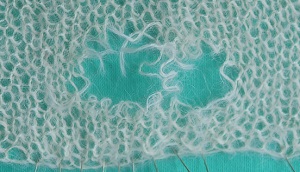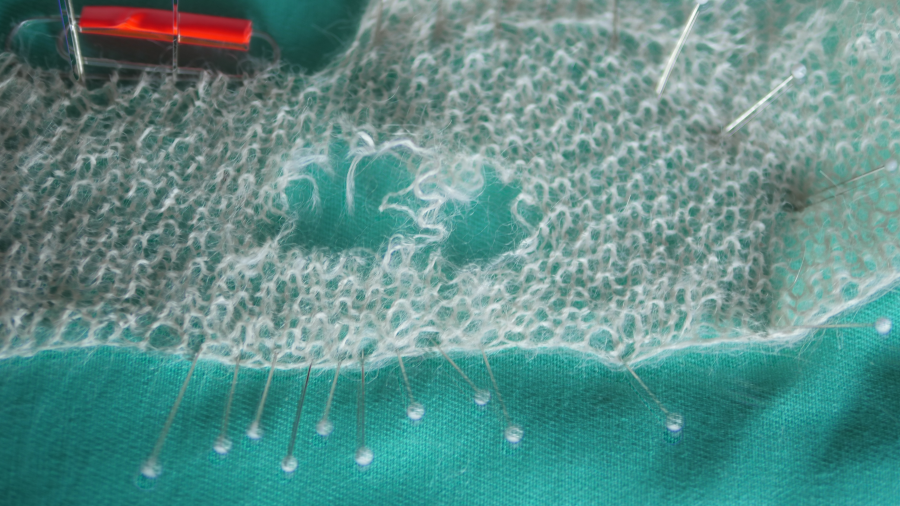 Fixing the hole in this seed stitch piece was accomplished by using Duplicate Stitch to a seal the stitches to the left and right of the hole. Then forming new stitches where the yarn was missing. The last row was grafted.
Fixing the hole in this seed stitch piece was accomplished by using Duplicate Stitch to a seal the stitches to the left and right of the hole. Then forming new stitches where the yarn was missing. The last row was grafted.
First, I spread the tear out on a surface I could pin into - in this case a small quilt pinning board but a folded towel would also work. I tried to get the bottom row of open stitches in as straight a line as possible. Also try to maintain the distance between stitches that match your gauge.
Then I inserted pins into each open stitch of the bottom row in a straight line. These pins mark the last intact row of knitting.
I extended the pins for three or four stitches to the left and right of the open stitches, being really careful that those newly pinned stitches were indeed in the same row as the open stitches.
 Once those three or four stiches to the left and right of the hole are marked, I add pins to the stitches in the row immediately behind those marked stitches. These new pins are actually marking the row that will start the repair.
Once those three or four stiches to the left and right of the hole are marked, I add pins to the stitches in the row immediately behind those marked stitches. These new pins are actually marking the row that will start the repair.
I normally graft from right to left and found the thought of having to graft in the opposite direction too confusing. So I folded a longer piece of yarn in half and then pinned that halfway point off to the right of the first right pin. I ended up with more ends than ideal but I maintained my sanity!
I threaded one end of the yarn into a blunt pointed needle. Removing the first pin to the right, I started duplicate stitching on the pin immediately behind the removed pin (removing that back pin is helpful but note which stitch you are working on). That second row of pins marks the first row of missing knitted stitches. As I finished duplicate stitching each stitch, I would remove the next front pin and duplicate stitch the next back stitch.
Once you reach the first open stitch, you now have to start forming new stitches. A crochet hook is helpful in pulling the yarn through to form the missing knit or purl stitch. Remove the pin, form the missing stitch, and then pin the new stitch in place. Try to maintain the loop size and spacing as you form the new stitches.
When you reach the double row of pins, switch to duplicate stitching for three to four stitches to the left.
For the second row, I used the second end of the repair yarn. Weave it up to the next row. Duplicate stitch and reform stitches as described above.
My repair required five rows of repair. I used a second length of yarn for rows three and four.
The last row was grafted so that the last repair row and the shown open stitches at the top of the picture were joined together.
Normally grafting replaces both legs of a stitch but I did cheat a bit on the grafting row. Seed stitch is a bumpy fabric so when I got confused, I made sure there was at least one loop through an open stitch to keep it from raveling. Your eye will look for that bumpy seed stitch look but will ignore a missing leg of a stitch.

